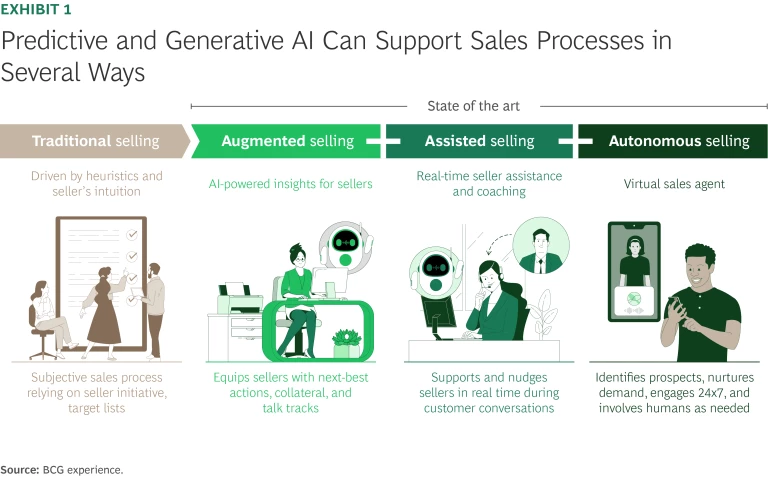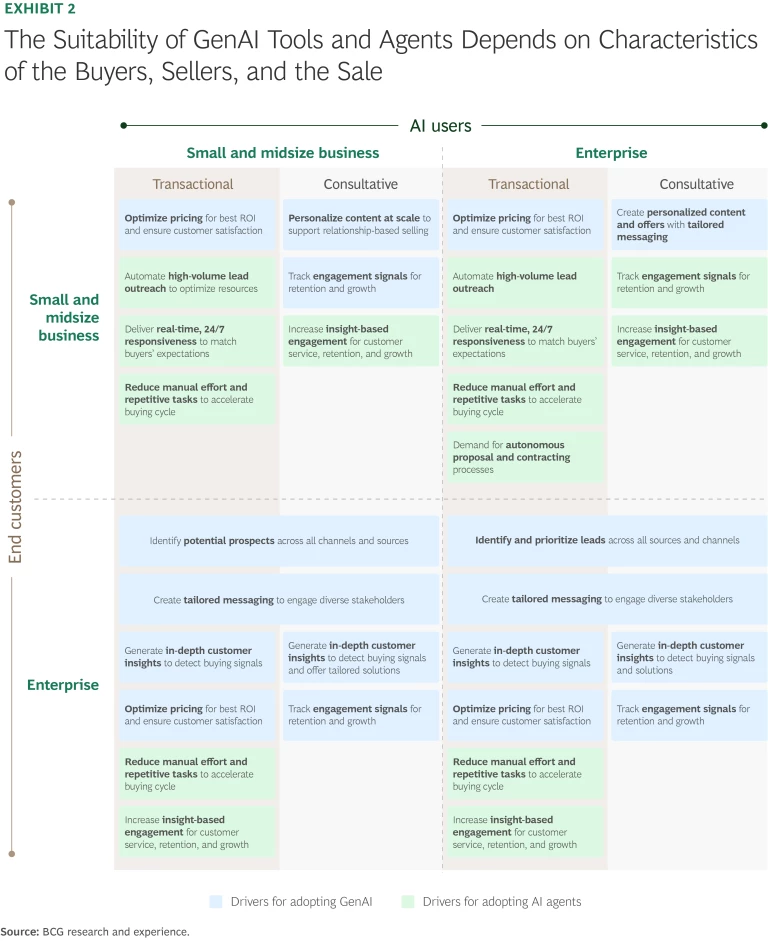The future vision for B2B sales—with humans and AI working in tandem to achieve outcomes neither could deliver alone—is moving from theory to reality. Our recent survey of B2B sales professionals revealed three strong viewpoints: salespeople want that vision, managers see the need, and customers increasingly expect it.
As shown in Exhibit 1, the traditional reliance on the intuition and experience of individual salespeople is giving way to a more systematic approach built on three forms of interaction with AI agents.

- Augmented selling. In this method, AI enhances sellers’ decisions by equipping them with talking points and collateral and recommending next-best actions. It also automates and personalizes cadences across email, chat, and social media to help orchestrate the sales process.
- Assisted selling. At this level, AI acts as a real-time partner by listening during calls, offering real-time prompts, drafting follow-ups, and updating CRM or ERP systems. Sellers can stay focused on customers while AI manages detailed or standardized sales tasks behind the scenes.
- Autonomous selling. At the most advanced level of AI-enabled sales, AI independently engages with customers. It prioritizes inbound demand, nurtures leads, qualifies opportunities, and handles standard tasks and actions across all touchpoints: email, text, in-app, websites, voice, and video.
Humans and AI working together in sales can deliver significant improvements in new customer acquisition, upselling and cross-selling, churn reduction, pricing realization, and seller productivity. It can also make sales journeys faster, more relevant, and more consistent. The challenge for organizations is to move beyond using AI for tactical process improvements and instead use available and emerging technologies to fully reimagine the way they sell.
In our survey, a majority of salespeople and managers expressed excitement about the prospect of AI becoming a strategic partner by doing more than automating end-to-end workflows. Managers highlighted that AI is already improving outreach and productivity, but noted that its full potential to enhance deal conversion and customer relationships remains largely untapped.
Stay ahead with BCG insights on artificial intelligence
The Gap Between Vision and Reality
The current widespread adoption of AI hints at this potential for a new era of B2B sales. Roughly seven in ten sellers rely on general-purpose AI tools for tactical productivity tasks such as drafting emails, summarizing calls, or automating follow-ups. But the uneven impact of AI in the workplace reveals how far most organizations still are from embedding it into their core sales workflows.
There are many different reasons for this tactical and relatively slow adoption of AI tools. In terms of performance, more than four out of five sellers cite inaccuracy and poor data integration as obstacles. This results in humans double-checking AI output, which erodes efficiency gains. And roughly three in four sellers feel under-supported in using the technology, with training offerings too episodic to build lasting confidence.
In terms of strategy for implementing AI, most companies have taken a conservative approach, focusing on narrowly defined pilots that aim for incremental efficiency gains. This may reflect the dilemmas that leaders face. While under pressure to deliver short-term benefits, they recognize that meaningful transformation takes time. They are also wrestling with the decision of whether to build, buy, or adopt hybrid approaches as technologies advance rapidly.
How AI Agents Bring the Vision to Life
Unlike today’s isolated AI tools that operate with limited data access, a future ecosystem of specialized AI agents will be contextually aware of every relevant data point and organizational resource because they will seamlessly tap into the entire sales technology stack. The power of these agents also derives from their ability to draw on the specialized expertise of internal teams, when necessary, to optimize decisions and execute tasks. We expect this ecosystem to feature five specialized agents working together.
- Orchestration agents break down high-level growth goals into workflows and coordinate execution across agents and teams.
- Lead generation agents decide whom to pursue, when, and through which channel. They search, consolidate, and score leads using signals derived from first- and third-party data as well as historical performance.
- Qualification agents determine whom to engage, in what order, and when. They propose solutions in real time, develop a value proposition, estimate ROI, and map buying groups.
- Deal conversion and pricing agents craft proposals, communicate pricing based on deal characteristics and pricing guidelines, coordinate legal and finance inputs, and accelerate deal closure.
- Customer success agents drive adoption, identify and mitigate churn risks, and trigger expansion plays based on real-time usage insights.
Balancing autonomous actions of AI agents and human oversight of them differs by the size of the business and the nature of the sales. (See Exhibit 2.)

For large strategic accounts, where purposeful human involvement is essential, agents can assist with account planning, territory design, quota setting, and complex stakeholder and deal management. But for smaller accounts or transactional sales, AI agents can act more autonomously. They can prioritize inbound demand, manage outreach at scale, and engage accounts that sellers could not profitably serve before. This combination of human and AI sales activity allows organizations to unlock both growth and efficiency, while allowing for purposeful human oversight where judgment and relationships matter most. Organizations can penetrate deeper into strategic accounts and expand coverage across the long tail.
Five Imperatives for the Future of AI-Enabled Sales
Leaders must act decisively to capitalize on the benefits of fully integrating AI into the sales function. These imperatives are structurally similar to BCG’s guidance for most AI transformations, but show the detail required to make them work within a B2B sales environment.
Define a bold and specific North Star.
Leaders need to reimagine customer experiences, commercial outcomes, and the roles of sellers. This includes having concrete, measurable KPIs and a timeframe for AI implementation. Pioneering firms are already moving beyond generic efficiency gains to measure performance gains such as improved conversion rates and increases in quota or territory coverage.
Chart a purposeful course.
Success will depend not on the number of AI tools, but on how the organization prioritizes and sequences their deployment. Initial high-impact use cases deliver measurable outcomes, build trust, and help define processes and inputs based on seller interactions. Organizations can then think more boldly and systematically as they scale these early cases, reinforce data and workflow foundations, and embed feedback loops.
Build and integrate the right tech stack.
This has two elements. First, leaders must make deliberate choices on out-of-the-box tools, scalable platforms, custom builds, and vendors. Second, they need to stress why data quality and integration are essential. Fragmented technology undermines integration, manifesting in do-it-yourself approaches and the rise of shadow IT teams to supplement AI centers of excellence. And when information is fragmented or poorly connected across tools, IT and tech teams will spend more time reconciling how AI agents engage with each other instead of advancing customer engagement.
Strengthen responsible AI governance and guardrails.
AI solutions often simplify data collection, but this compounds the importance of CRM hygiene and strong data governance. Organizations must enforce clear views of customers, unify standards, and establish safeguards to ensure accuracy, compliance, and brand trust. They also need to develop clear guardrails for what AI agents can and cannot do, designate approved data sources and how to use them, and design structured feedback loops to continuously improve performance.
Drive adoption through people and leadership.
The breakdown of successes and challenges in our survey validated BCG’s 10/20/70 rule: 10% of a company’s efforts should be focused on algorithms, 20% on technology and data, and the remaining 70% on people and processes, which produce most of the value of an AI transformation. Such significant change in B2B sales requires top-down engagement with a clear mandate as well as ongoing enablement to upskill talent and foster frontline confidence. Organizations will also need to redesign roles and align incentives.
The growing maturity of AI technology makes it possible to imagine a future where B2B sales is faster, more intelligent, more empathic, and more data driven. Far more than an efficiency play, AI will automate execution, orchestrate scale, and deliver better customer experiences. Leaders who set a bold North Star, invest in capabilities, and commit to purposeful human oversight alongside automation will redefine what world-class sales performance looks like in the decade ahead.
This transformation is already underway. Deep Customer Engagement AI by BCG X , for example, is helping organizations realize the full potential of AI-driven sales by enabling hyper-personalized, end-to-end customer management at scale. Companies using the solution have seen up to a 50% increase in customer acquisition, a 20% rise in upselling and cross-selling, and as much as 40% higher lifetime value from their client portfolios. These results illustrate how embedding AI agents across the customer journey can translate strategic vision into measurable commercial impact.
The findings in this article are derived from a BCG Center for Customer Insight survey of 400 US sales representatives and managers across multiple industries, examining their views on GenAI adoption, use cases, and challenges.






